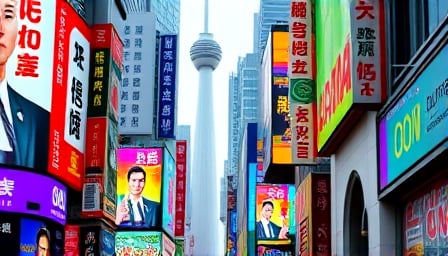Guangdong Advertising Group Co Ltd: Navigating a Volatile Media Landscape
The Guangdong Advertising Group Co Ltd (GIGC), listed on the Shenzhen Stock Exchange under the ticker SZ002400, has traded at 8.89 CNY on 16 September 2025, a modest decline from its 52‑week high of 13.12 CNY and a modest rise from its low of 4.66 CNY. With a market capitalization of roughly 1.55 billion CNY and a price‑earnings ratio near 151×, the company’s valuation reflects the broader uncertainty that has gripped China’s cultural and media sectors.
1. Sector‑Wide Headwinds
On 17 September, market commentary from People’s Financial News highlighted a weakening trend in the cultural and media board. Major players such as Happiness Blue Sea, China Film, Jisi Media, Yue Media, and Sichuan Broadcasting Group all fell by more than 8 percent, indicating that advertising spend and media consumption were under pressure. For a company whose core business revolves around advertising design, production, and consultancy, such a downturn in the media ecosystem can translate into tighter budgets, more selective campaigns, and increased competition for client wins.
2. Broader Market Dynamics
While the media sector was in retreat, other segments showed resilience. On 16 September, the Shanghai Composite slipped marginally by 0.04 percent, yet the ChiNext index rallied 0.68 percent, buoyed by a surge in robot‑related stocks and high‑tech chip firms. The market’s overall trading volume climbed to 2.34 trillion CNY, reflecting a surge in investor activity even as volatility persisted.
The juxtaposition of a sluggish media market against a buoyant high‑technology sector underscores a shift in investor sentiment toward innovation and automation. For Guangdong Advertising Group, this presents both a challenge and an opportunity: while traditional advertising demand may be waning, the rise of digital platforms—especially those linked to short‑video and live‑streaming—offers new channels for creative services.
3. Digital Disruption and the “Douyin” Concept
A separate report from 16 September noted that the “Douyin” (TikTok) concept was gaining traction, with Sichuan Broadcasting Group hitting a price limit and other media‑centric names such as Blue Light Mark, Tianlong Group, and Yidian Tianxia enjoying near‑9 percent gains. The surge in short‑video traffic suggests that brands are reallocating spending toward platforms where engagement metrics can be measured more directly.
Guangdong Advertising Group’s website (www.gimc.cn ) showcases a portfolio that includes photography, printing, exhibition hosting, and digital media production. Leveraging the Douyin concept could be a strategic pivot: by developing content that aligns with the platform’s fast‑paced, algorithm‑driven ecosystem, the company may tap into a new customer base that values short, high‑impact visuals.
4. Strategic Considerations
Given the current market environment, Guangdong Advertising Group faces several strategic decisions:
| Area | Implication | Possible Action |
|---|---|---|
| Client Mix | Traditional media spend shrinks | Expand services in digital marketing, data analytics, and influencer collaborations |
| Pricing | Competitive pressure rises | Offer bundled packages that integrate design, production, and digital distribution |
| Talent | Need for digital specialists | Recruit or train staff in short‑video content creation, AI‑driven design tools |
| Capital Allocation | Volatility in earnings | Maintain a conservative cash reserve while investing in scalable digital platforms |
5. Outlook
The company’s recent performance—closing at 8.89 CNY—mirrors the broader media industry’s struggle to maintain momentum amid shifting consumer habits. Yet the rise of high‑growth segments such as robotics and short‑video platforms indicates that the advertising ecosystem is not static. Guangdong Advertising Group’s diversified service mix, coupled with a potential pivot toward digital‑first strategies, could position it to capture emerging opportunities.
In the short term, the firm may experience modest volatility as investors reassess its valuation relative to peers in the Communication Services sector. Over the medium term, success will hinge on the firm’s ability to translate its traditional strengths into the new digital paradigm, aligning creative output with platforms that deliver measurable engagement.
